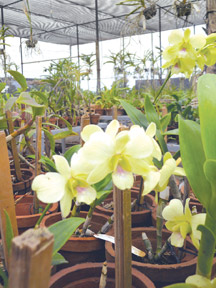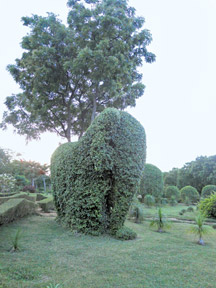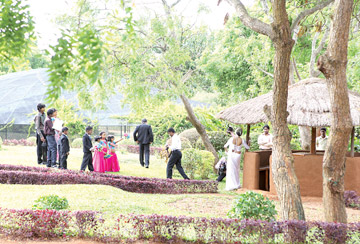Tourism promoted through botanical garden concept
By Dhaneshi YATAWARA
People need nature to thrive. Sri Lankans are lucky in that sense
living in a world renowned biodiversity hot spot. Yet, people seemed to
have missed the golden fact of conserving nature for the future
generation to thrive. Thus, it has become mandatory for a Government to
be responsible for the conservation of the nature.
 |
| The 'owners'
of the land still roam freely |
 |
| Orchids grown
with special care |
 |
| Tamed creepers
create beauty for the eye |
|

The garden creates the ideal location for photography |
Many steps are taken, and establishing Botanical Gardens is one key
factor in conserving the floral gene pool of Sri Lanka. The prime
objective of a Botanical Garden is conservation as diversity and
endemism of plants are quite high in Sri Lanka. There is a distinct
difference between the country's wet zone and the dry zone flora.
Flowering plants
As the country's wet zone, which accounts for nearly quarter of the
total land area of the country is the home for almost 88 p.c. of our
flowering plants. Throughout the history it is the wet zone that
received much attention in plant conservation.
Just important as Tropical Rain Forests in the wet zone, the Tropical
Dry Mixed Evergreen Forests and Tropical Thorn Scrub Forests that are
found in the dry zone, composes a major part of Sri Lanka's forest
ecosystem. It has been on the top two forest types that covers a larger
part of our country.
Tropical Dry Ever Green Forests cover over 1.09 million hectares of
the island and Tropical Thorn Scrub Forests cover slightly more than
0.46 million hectares, according to the Department of Botanic Gardens
referring to the latest available statistics of the country's forest
cover. Yet it has not received proper attention in conserving its plant
gene pool. Unfortunately in the past history of the country more focus
was given to establish Botanic Gardens in the Wet zone conserving the
gene pool of forests and vegetation of the wet zone.
Though dry zone flora is included in 'ex situ' conservation attempts
of the already established botanical gardens in the country, botanists
believe that conserving plants in its own environment would be ideal to
keep those genes in its original state. When the weather changes from
area to area plants with changes in the gene sequence may win the chance
of survival while the plants with the original gene sequence die. After
all, fittest only survive under Mother Nature's rule.
Dry Zone
Initiating conservation attempts in the Dry zone, Sri Lanka started
the plan for its first Dry zone Botanic Garden and location was selected
in the coastal city Hambantota. Of the Sri Lankan climate zones,
Hambantota poses an ideal dry semi-arid type of climate. The major rainy
season is the northeast monsoon. The area is situated in the lowest
peneplain of the island, which stretches from Trincomalee to the
Hambantota coastal plain. The annual rainfall is between 750-1,000
millimetres in the dry parts of Hambantota. Thus, the site of the new
botanic garden, at Mirijjawila in the Hambantota district is ideally
suited for this project.
It is like the oasis of the flat terrain of the dry zone. Covered in
lush green mixed with dusty brown patches this unique patch of land in
Mirijjawila is getting to the shape of which will be Sri Lanka's first
ever native botanical garden. Today it is waiting until the set plants
grow. "The benefits of conserving dry zone habitat and its distinctive
vegetation are largely long-term. The rich agro-biodiversity in the
island's farming systems is experiencing many threats due to unplanned
land use, pollution, fragmentation and alteration of farming systems. By
conserving these genes the more important components of the
agro-biodiversity found in the dry zone will be safeguarded," said
Director General of the Department of Botanic Gardens Dr. Siril
Wijesundara.
Accordingly, it is these dry zone plants that would carry the drought
resistant genetics. It would be a main source in researches for
developing new agricultural crops to suit climate changes that take
place on earth. Thus raises the dire need of ex situ conservation of
such plants.
Purely Sri Lankan
This will be the first new botanic garden in Sri Lanka in 130 years.
"Developing a new Botanic Garden in Sri Lanka is a major undertaking. It
takes years to develop and critically - to grow. The new garden has to
meet the many expectations, and the needs, of a wide range of people to
suit the needs of the new century," Dr. Siril Wijesundara said.
"In the twenty-first century there is no requirement to follow any
traditional or classical pattern," Dr. Wijesundara added, explaining the
landscape of the garden. "The few specialist dry zone botanic gardens in
the world, particularly in Australia and in North America, are not
similar to each other either. So there is no pattern, design or
precedent to follow," he added.
Water tanks
Three water tanks - namely Kohombagas wewa, Malitthangas wewa and
demataththa wewa, are available in the garden premises to preserve the
moisture of the land. "These tanks existed in this land and they were
abandoned at the time construction work started," Dr. Wijesundara said.
For the Botanic Garden Department this is an opportunity to define a
space, a garden layout, landscape design and distinctive public amenity
in a very modern way.
The long-term strategic benefit of the garden lies in its ability to
take propagated plant specimens away from forests and to promote the
herbal and floriculture industries, where there is significant potential
for growth internationally. Both of these industries can be developed to
meet the market potential, they hold strategic value and there is
significant economic benefit to be gained in these areas.
Herbal industry
The Botanical Garden Department plans to make the garden to become a
centre for the promotion of the herbal industry. The Herbal industry
will be supported as the garden will hold a specialised herb collection.
The dry zone supports a large number of medicinal plants that are used
in Sri Lanka presently. These are valuable plants which can be used in
the development of the herbal industry, one of the fastest growing
industries in other countries in this region.
Tourism and industries
Floriculture has also been highlighted as an area of both national
policy priority and where worldwide growth is also marked significantly.
Already the national botanic gardens have developed expertise in
Anthuriums, Orchids, Gerberas and other varieties. "Complementary
additions of Dry Zone plant varieties will be immensely valuable, and of
interest to national growers and societies, and international groups,"
Dr. Wijesundara said.
Its location at the intersection of Hambantota-Suriyawewa Road and
the proposed Colombo-Kataragama main road will also attract a large
number of local visitors. "Experience of running the national botanic
gardens of Peradeniya and Hakgala has demonstrated the business case for
tourism, with both gardens being profitable and a major feature on the
tourist trail," Dr. Wijesundara said. Thus, the new Dry Zone Garden will
follow this established, and tried and tested pattern. Southern Sri
Lanka has been earmarked as a development zone for tourism, and a
Botanic Garden presents an attractive visitor location both for domestic
and foreign tourists.
The National Census of Population and Housing in Sri Lanka done in
2001 indicates that 906 people in the Hambantota area were employed in
bars, restaurants and canteens and 850 people employed in hotels and
other accommodation facilities.
"There is evidence of a need for economic development activity within
the area rather making people leave the area seeking jobs if their
actual wish is to stay in the village. I believe tourism promoted
through the botanical garden should bolster economic development
efforts," Dr. Wijesundara said.
At the stage of construction and building, local craftsmen and
labourers are used. "Many of these jobs will be in full time employment,
and long lasting such as maintenance and construction work. Other job
opportunities will be created over the longer term," he said. Craft or
art work will be for sale at local level, stimulated by greater public
exposure to products or services.
A new public amenity will stimulate the local market economic in all
manner of ways, and promote local economic development in the area.
|


